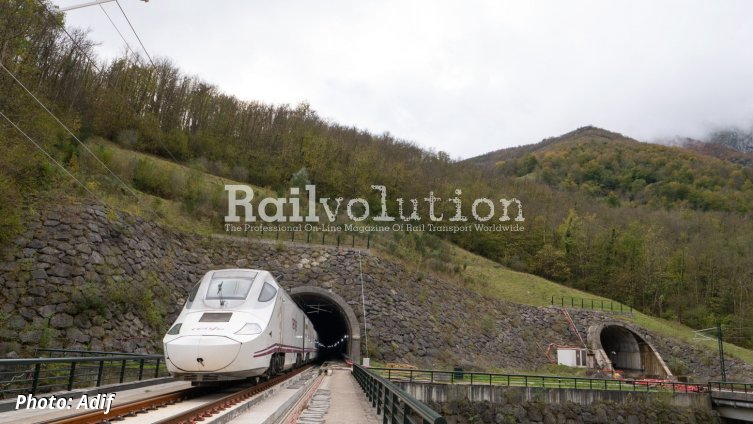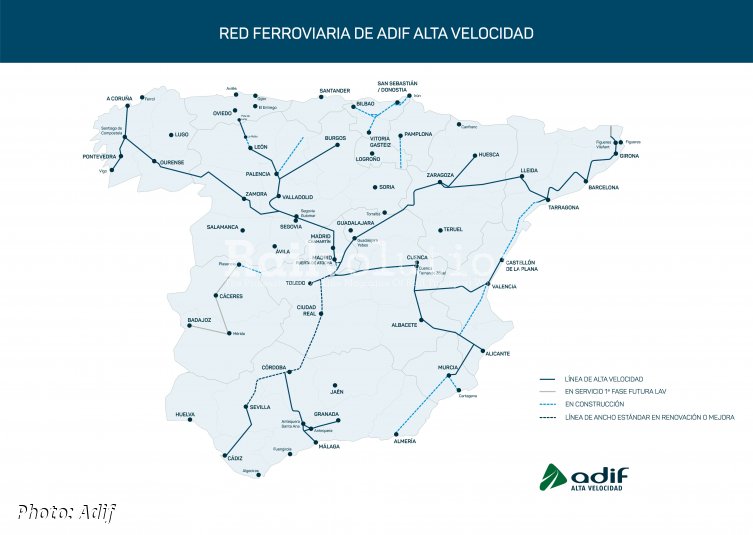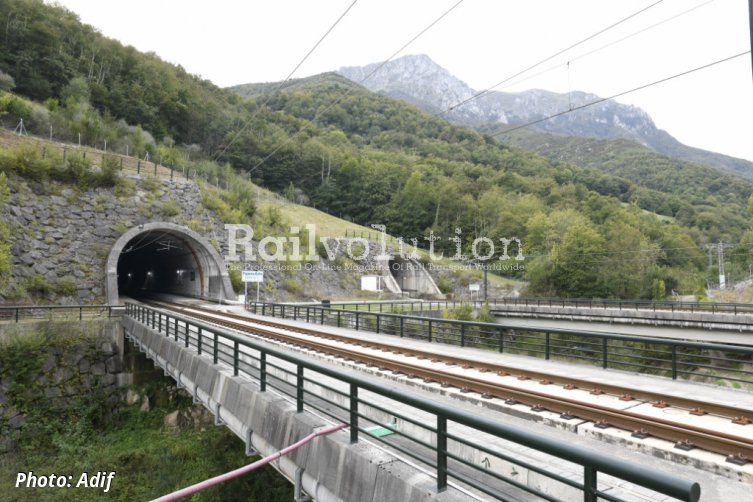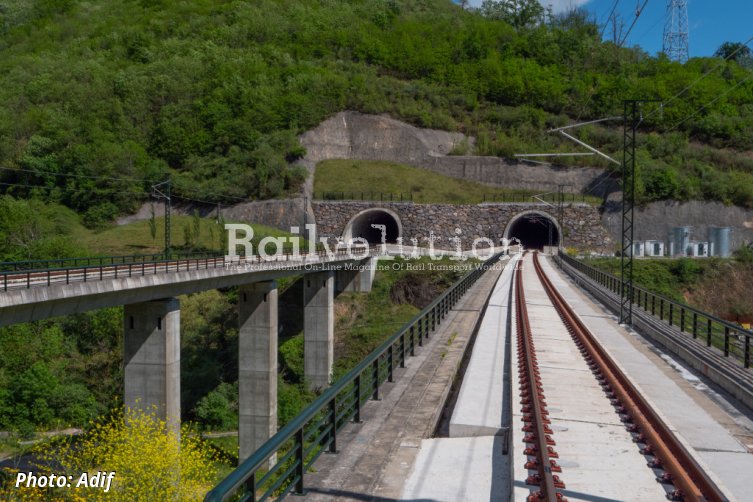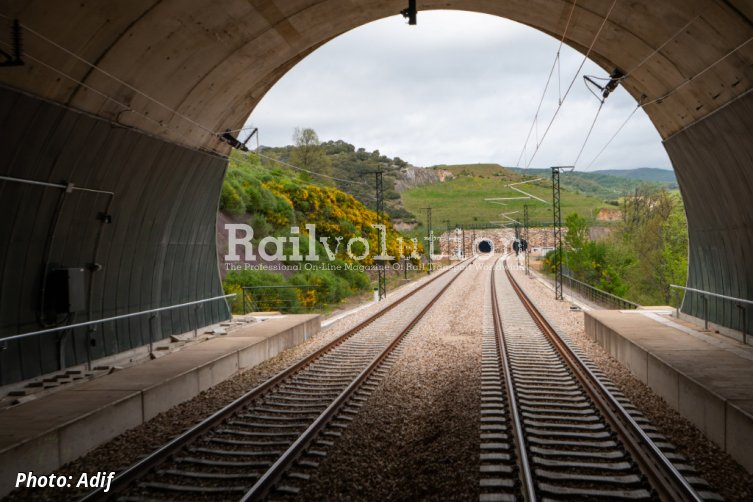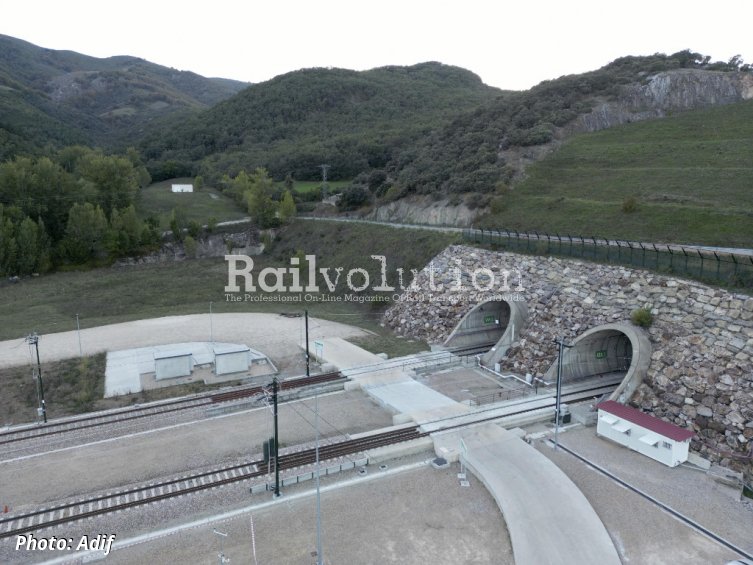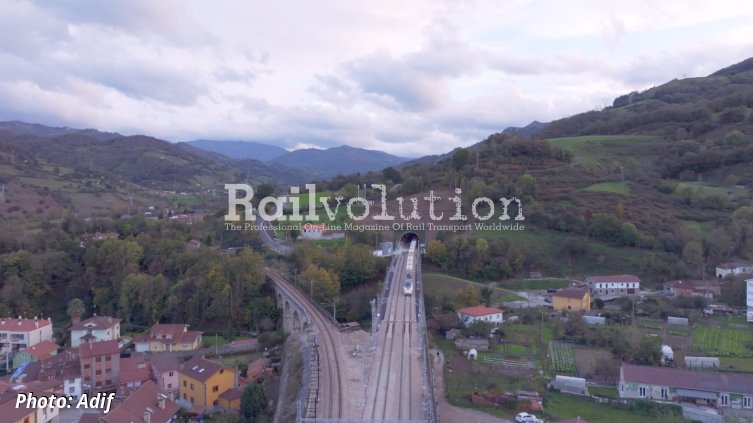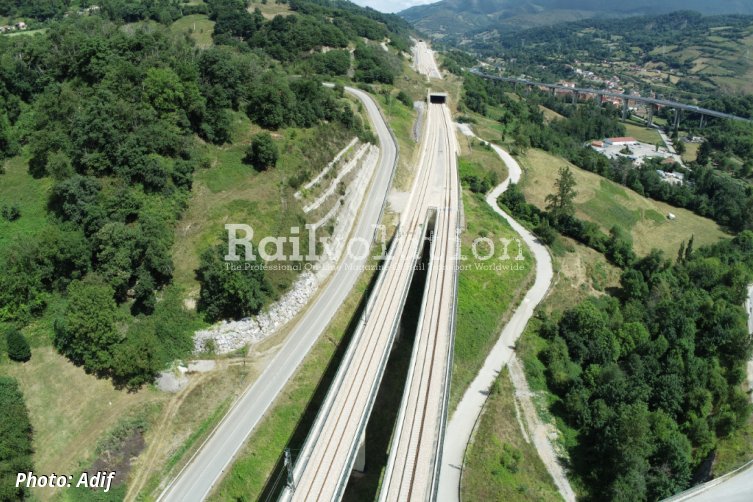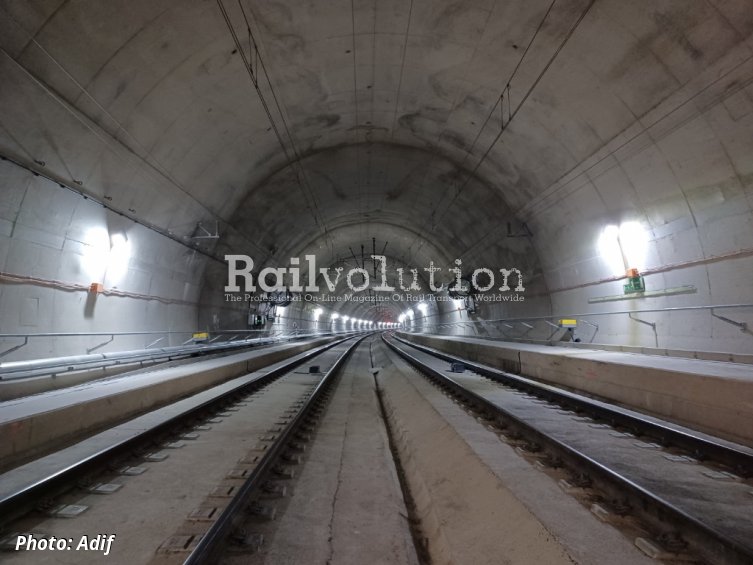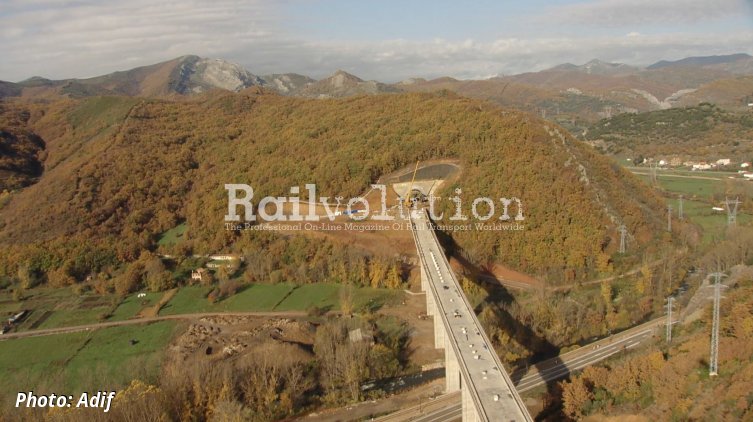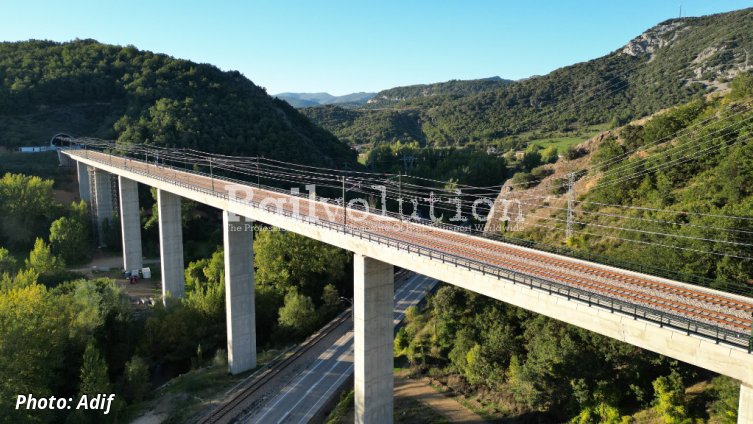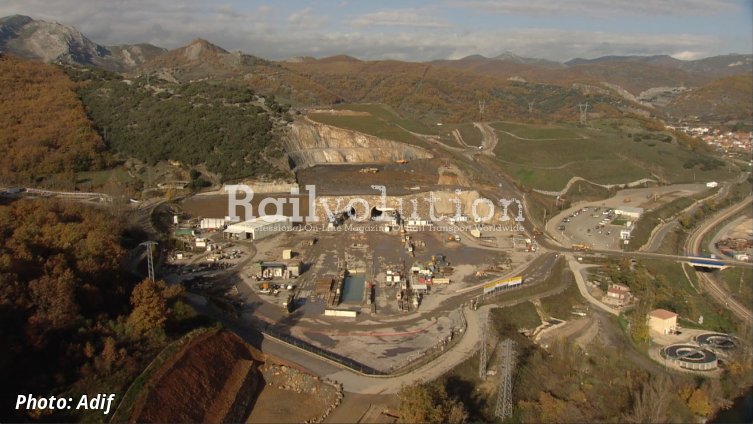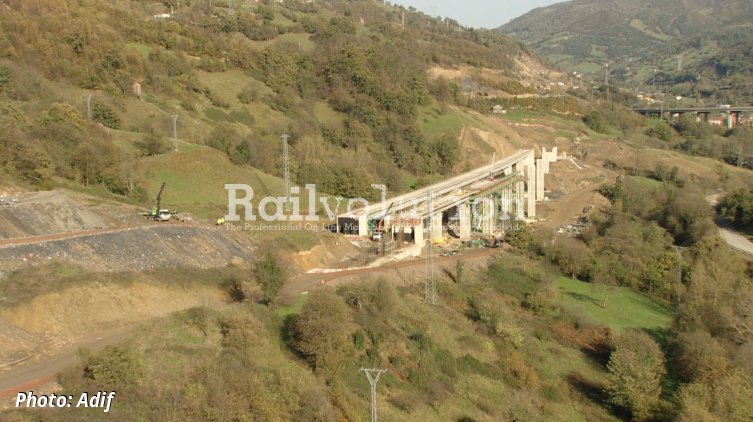Variante de Pajares inaugurated (1)
posted on 1st Jan 2024 19:03
On 29 November 2023 at 13.35, five minutes late, a Class 130 ALVIA departed from Madrid-Chamartín, bound for Oviedo, the new, fast way, via the base tunnel under the Cordillera Cantábrica. On board were King Felipe VI, Prime Minister Pedro Sánchez, the new MITMA minister, Óscar Puente, and the heads of government of the autonomous region of Castilla y León, Alfonso Fernández Mañueco, and of the Principality of Asturias, Adrián Barbón. Prior to departure 86 year old padre Ángel García, the president and founder of the NGO Peace Messengers (Mensajeros de la Paz), announced that 'From today, Asturias really does belong to Spain'.
The northern portal of the 28.4 km Guadarrama tunnel was entered at 13.59, the train then travelling at 248 km/h, and lunch (cold meats and cheeses, salmon, and fruit salad) was then served. Valladolid was passed at 14.32 and Palencia at 14.55, León being reached at 15.39. By now all the seats were occupied, and some of the invited passengers were obliged to stand - a rarity on a high speed train service in Spain, where capacity is strictly limited to the number of seats!
Departure from León was at 15.52, the train traversing the cut-and-cover tunnel north of the station at 40 km/h. At San Andrés de Rabenado, in the northern suburbs of the city, there was a protest group standing beside the tracks, urging the politicians on board the train to have the line here put underground. Even with the sparse train service on the line to Asturias, such is the strength of indoctrination by politicians and the media that the railway is now regarded by the general public as an 'architectural barrier´, whereas busy urban roads are not.
At 16.05 the train left the conventional main line, just south of La Robla, joined the Variante and accelerated from 160 to 200 km/h. The passage through the base tunnel took 11 minutes, and the gauge-changer at Campomanes was left at 16.18, Pola de Lena station being passed at 16.21. The train reached Oviedo station at 16.45 after a journey of 3h10, and passengers were greeted by a gaita (Asturian bagpipe) player on the platform. All participants then rode the escalator to the outdoor concrete raft, two floors above the tracks, where the inaugural speeches took place under the huge arched canopy - rain was threatening.
Pedro Sánchez commented: 'Not only has Asturias been brought closer to the rest of Spain, as everyone has said, but the rest of Spain has been brought closer to this autonomous community which has a singular beauty and geography.'
Closing his speech, Sánchez also repeated, in paraphrase, the words of the late 18th century academic and erudite Gaspar Melchor de Xovellanos y Ramírez: 'The one thing this land (referring to Asturias) lacks are illumination and communications. The illumination that comes through making available to the common people education and science, and communications to overcome the geographical barriers.'
The new MITMA Minister, Óscar Puente, reckoned that the Variante de Pajares is 'The most important feature on the Atlantic Corridor, and will result in the saving of thousands of tonnes of CO2 emissions annually. The socio-economic impact of the new railway will be great indeed, on account of the improvement in connectivity, enabling local markets to be integrated, more employment opportunities to be created, and a multiplier effect on tourism in Asturias. It is true that the completion of this rail link between Asturias and the Meseta has taken rather longer than would be desirable, but what is undeniable is that it will serve to integrate these regions. That will justify to the last centimo the four million EUR spent on it.'
At 17.55 the special train then returned south, again via the Variante de Pajares, to León (18.57) and Madrid-Chamartín (21.05). Public services started the following day.
A century of projects
Nearly two decades have now elapsed since 11 February 2004, when the then Minister for Transport, Francisco Álvarez Cascos, and Deputy Prime Minister Rodrigo Rato participated in a formal ‘foundation stone laying’ at Pola de Lena. The ‘foundation stone’ was in fact a symbolic segment of tunnel lining, placed in the open air, together with a kilometre post km 55.090, beside which Cascos and Rato performed a sort of dance. Cascos was fond of these symbolic kilometre posts. There is another at La Carrera halt, between El Berrón and Pola de Siero, commemorating the (still unfinished) doubling of the track between these two locations. A few weeks after 11 February the tunnel lining segment mysteriously disappeared...
The Variante de Pajares has been a dream for close on a century. In the 1930s the Ferrocarril Vaso-Asturiano extended its metre gauge line from Figaredo up the Aller valley to Collanzo, with hopes of building a further extension over and through the Cordillera to Matallana, on the Ferrocarril de La Robla’s line from the Bilbao/Lutxana to León/La Robla. The outbreak of the Civil War prevented this scheme, intended to divert some of the coal traffic from the Norte’s congested line over Pajares, from getting beyond the project stage.
With coal traffic continuing to increase as Spain industrialised following the Civil War, there were more schemes. In 1954 the Comandante del Servicio Militar de Ferrocarriles, Fernando Muñiz Aza, proposed the creation of a twin-bore tunnel, 15 km long, one bore for a double track railway, the other for a road.
By the late 1970s the heavy industries in central Asturias, notably the vast new UNINSA steelworks at Trasona (near Avilés) and Veriña (near Gijón), were generating considerable amounts of rail traffic, even though the movement of coal was declining as the number of pits, and volume of production, in Asturias started diminishing.
In RENFE’s 1979 - 1982 Plan General de Ferrocarriles a number of proposals for a direct rail route under the Cordillerra were examined, all with gradients of between 15 ‰ and 18 ‰. Then in 1984 came a geological and geotechnical survey, from which RENFE devised a scheme envisaging a railway with a gradient of 20 ‰ and curves with a minimum radius of 2,000 m. None of these schemes prospered.
It was on 20 November 1997 that Act 47/1997 was approved in Parliament giving the green light for the Variante de Pajares. This was incorporated in the Plan de Infraestructuras del Transporte 2000 - 2007 as part of the proposed national high speed rail network. The pertinent Informative Study received the green light in October 2002, enabling the preparation of the Basic Project, and the adjudication of the construction, in four sections, in June 2003. At the time a 1,668 mm gauge, mixed-traffic railway, suitable for speeds of up to 290 km/h, was envisaged.
The project was fated from the start. Not only did the commemorative tunnel lining segment disappear, but the bombing tragedy in Madrid of 11 March 2004 resulted in a change of government, and one of Public Works Minister Magdalena Álvarez’s first actions was to re-invite tenders for three of the sections of the Variante - it was reckoned illegal to award project preparation and project construction to the same contractor.
Work starts!
Work on the base tunnel got under way in 2005, with the first TBM starting work on 13 July, with Prime Minister José Luis Rodriguez Zapatero calmly predicting that the new railway (and not just the civil engineering structures) would be ready for use in ... 2009! In the latter year, on 11 July, both base tunnel bores were indeed completed, but little else.
There followed a decade of nasty surprises, bungling and interminable debates, with numerous false predictions of when the new railway would be ready for use. By 2014 it was evident that the twin bores had intercepted various underground streams - on the southern side of the Cordillera there were numerous villages whose local water supplies had suddenly dried up. The subterranean streams instead penetrated the tunnels, which were now flooded to a depth of around a metre, and flowed out at Los Pontones, in Asturias, where a water treatment installation had to be built.
At Campomanes, slope stability above the line threatened serious landslides, resulting in the construction of massive retaining walls and the use of concrete grids to stabilise areas of mountainside high above the tracks. By 2016 there was still a stretch of trackbed to be built between there and Pola de Lena. It had been forgotten that when the A-66 motorway had been built in the early 1980s it had been routed to the opposite side of the Huerna valley on account of known slope instability at this location.
Although by 2014 a contract for electrification had been awarded, it was impossible to start work on this, or on tracklaying, because nobody in government could decide on what track gauge, or combination of gauges, or what electrification voltages, should be used. With the Variante now being considered for mixed traffic, there was evidently a need to provide for rail vehicles of both gauges (1,435 and 1,668 mm), since at either end of the new line access to the 1,668 mm gauge network would be necessary. And the cost overrun was rising dramatically from the 1.085 billion EUR of the estimates in 2004 and threatening to top 4 billion EUR.
It was not until 2017 that Public Works Minister Iñigo de la Serna Hernáiz was able to sort out the mess, and work to complete the line began in earnest, with an inauguration date of ‘2020’ being mentioned. The work took longer than planned, partially because of the pandemic, and partially because of complications affecting manufacturing and supply chains.
End of part 1

